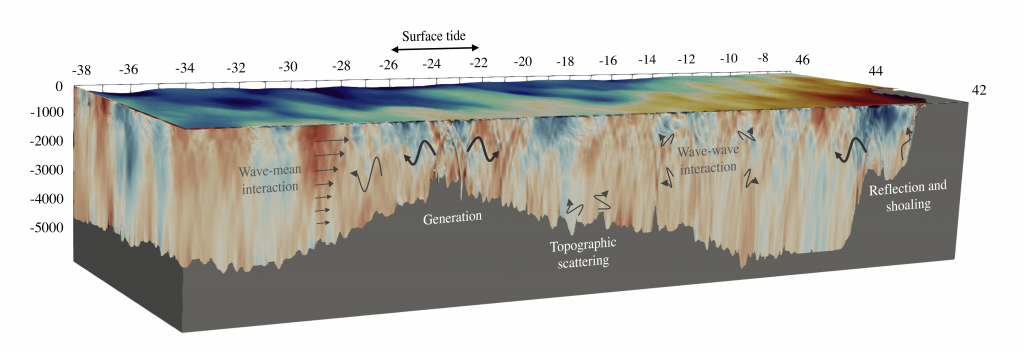
Diapycnal mixing specifically refers to the mixing of properties across isopycnals, and can roughly be thought of a mechanism by which oceanic properties are redistributed in the vertical. It impacts not only the interior stratification of the ocean, but also the distributions of biological and chemical tracers. Though mixing occurs at scales that are relatively tiny, it is ubiquitous and has influence at global scales, setting the rate at which the deepest waters in the ocean are raised back to the surface.
Ocean mixing occurs at centimeter scales and smaller, where gradients in water properties such as temperature and salinity are erased by molecular diffusion. It is driven by processes, such as turbulence, that enhance density gradients by stirring, allowing molecular diffusivity to proceed more rapidly.
Our research focusses on both the processes that lead to ocean mixing, such as breaking internal gravity waves or double diffusive phenomena; as well as the impacts of mixing on biological and chemical processes in the ocean. We use observations to motivate and validate a wide range of numerical models, from regional simulations using MITgcm, to large eddy simulations using Oceananigans, and idealized reduced complexity models that are developed in house. A few current projects are listed below:
- Estuarine circulation (see the Bedford Basin and Halifax Harbour Surveys);
- Impacts of physical dynamics on the efficiency and impacts of Ocean Alkalinity Enhancement;
- Measuring (using Rockland’s microrider on a Slocum glider) and modeling (using Oceananigans) near surface turbulence;
- Turbulence and mixing associated with plumes and jets using high resolution models and observations;
- Ocean mixing processes in the Canadian Arctic Archipelago;
- The structure of internal waves over sloping topography;
- The generation of internal tides at the coast, including superinertial coastal trapped waves and inertia-gravity waves;
- Double diffusion, salt fingering and lateral intrusions;